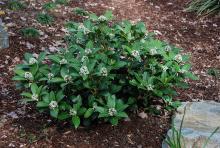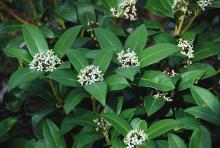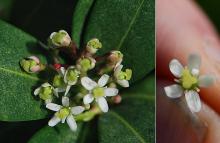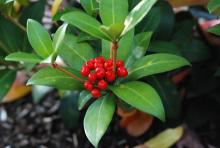Skimmia reevesiana
Common name:
Reeves Skimmia
Pronunciation:
SKIM-ee-a REEV-si-ah-na
Family:
Rutaceae
Genus:
Synonyms:
Skimmia japonica ssp. reevesiana
Type:
Broadleaf
Native to (or naturalized in) Oregon:
No
- Broadleaf evergreen, low growing shrub, 1-3 ft (0.3-0.9 m) high and 2-3 ft (0.6-0.9 m) wide. Leaves simple, alternate, lanceolate or oblong lanceolate, 2.5-10 cm long and 2-2.5 cm wide, leathery, acuminate tip, wedge-shaped base, margin smooth (entire), dark green above, light green below. Flowers are in terminal clusters 5-7.5 cm long, fragrant, white, each about 1 cm wide, 5-parted, both male and female parts present (bisexual, self-fertile). Fruit crimson, more or less spherical, about 8 mm long, persist into winter.
- Part shade to shade, prefers moist, acid, high organic matter soils, seldom needs pruning. Attractive in a container. It is self-fruitful in contrast to S. japonica which requires both male and female plants. The bisexual flowers of S. reevesiana are helpful in distinguishing it from S. japonica.
- Hardy to USDA Zone (6)7 Native to China and east Asia.
- Presumably this plant is as poisonous as S. japonica, which can cause cardiac arrest if large quantities are ingested. The red fruit is the usual cause of poisoning.
- reevesiana: in honor of John Reeves Jr. (1774 – 1856), an English naturalist and plant collector. He was responsible for the introduction of a number of garden plants to the West. Starting in 1812, Reeves was Assistant, and later Chief, Inspector of Tea for the British East India Company in Canton, China; returning to England in 1831.







